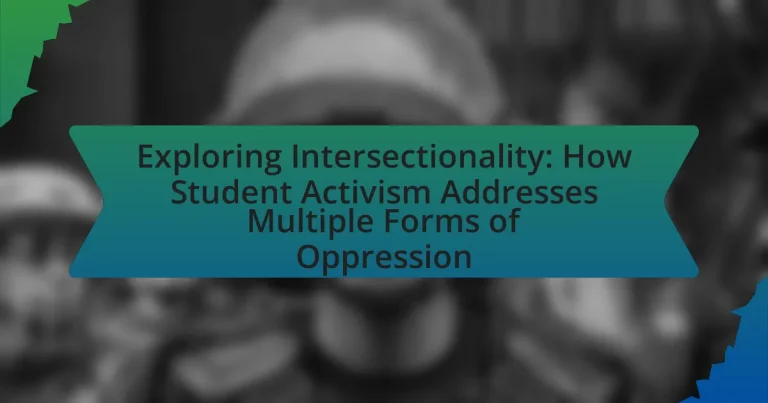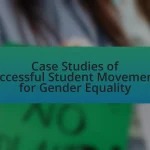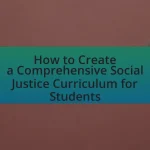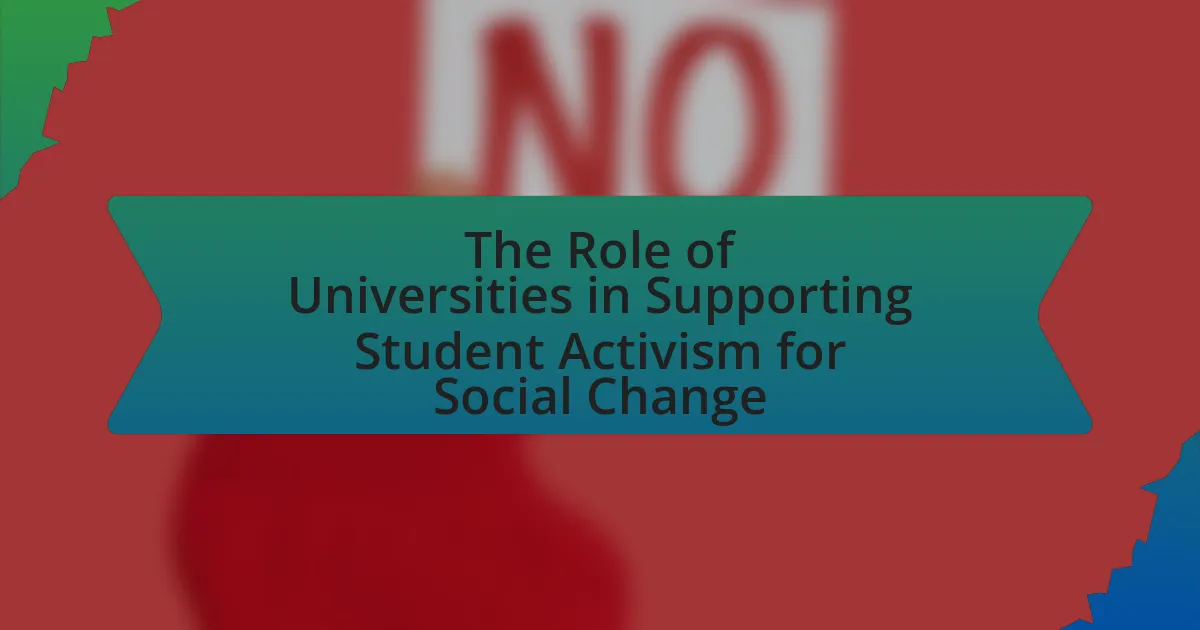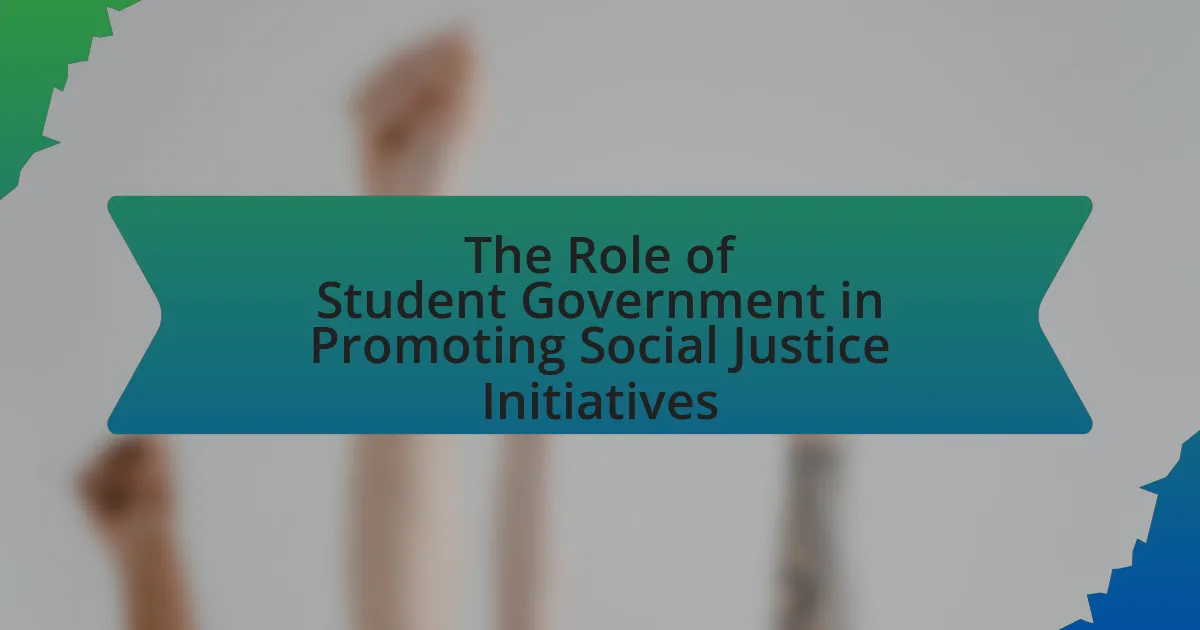The article explores the concept of intersectionality within student activism, emphasizing how overlapping social identities—such as race, gender, sexuality, and class—create unique experiences of discrimination and privilege. It discusses the influence of intersectionality on activism strategies, highlighting the importance of inclusive approaches that address multiple forms of oppression. Key principles of intersectionality are outlined, along with the challenges student activists face in representing diverse perspectives. The article also examines notable movements that exemplify intersectional activism, their impact on policy changes, and the lessons future activists can learn to enhance their effectiveness in advocating for social justice.

What is Intersectionality in the Context of Student Activism?
Intersectionality in the context of student activism refers to the framework that examines how various social identities—such as race, gender, sexuality, and class—intersect to create unique modes of discrimination and privilege. This concept, introduced by Kimberlé Crenshaw in 1989, highlights that student activists often face overlapping forms of oppression, which informs their advocacy and mobilization strategies. For instance, a Black female student may confront both racial and gender discrimination, necessitating a multifaceted approach to activism that addresses these intersecting issues. Research indicates that recognizing intersectionality allows student movements to be more inclusive and effective, as it fosters solidarity among diverse groups and promotes a deeper understanding of systemic inequalities.
How does intersectionality influence student activism?
Intersectionality significantly influences student activism by highlighting the interconnected nature of social categorizations such as race, gender, and class, which create overlapping systems of discrimination and disadvantage. This framework allows student activists to understand and address the complexities of oppression, leading to more inclusive and effective movements. For example, the Black Lives Matter movement, which emerged from student activism, emphasizes how racial injustice intersects with issues like gender inequality and economic disparity, thereby mobilizing diverse groups to advocate for comprehensive social change. Research by Crenshaw (1989) in “Demarginalizing the Intersection of Race and Sex” illustrates how ignoring these intersections can lead to inadequate responses to the needs of marginalized communities, reinforcing the importance of intersectionality in shaping activism strategies.
What are the key principles of intersectionality?
The key principles of intersectionality include the recognition that individuals experience overlapping social identities, which can lead to unique forms of discrimination and privilege. This framework, developed by Kimberlé Crenshaw, emphasizes that social categories such as race, gender, class, and sexuality do not exist independently but interact to shape individual experiences. For instance, a Black woman may face both racial and gender discrimination simultaneously, which cannot be understood by examining race or gender in isolation. Intersectionality highlights the importance of considering these interconnected identities to fully understand systemic oppression and advocate for social justice effectively.
How does intersectionality relate to various forms of oppression?
Intersectionality relates to various forms of oppression by highlighting how different social identities, such as race, gender, class, and sexuality, intersect to create unique experiences of discrimination and privilege. This framework, developed by Kimberlé Crenshaw, illustrates that individuals may face multiple, overlapping forms of oppression that cannot be understood in isolation. For example, a Black woman may experience both racism and sexism simultaneously, which compounds her marginalization in ways that differ from those experienced by a white woman or a Black man. Research indicates that understanding these intersections is crucial for effective activism and policy-making, as it allows for a more nuanced approach to addressing systemic inequalities.
Why is understanding intersectionality important for student activists?
Understanding intersectionality is crucial for student activists because it enables them to recognize and address the interconnected nature of social categorizations such as race, gender, class, and sexuality, which can lead to overlapping systems of discrimination or disadvantage. By grasping intersectionality, student activists can develop more inclusive strategies that consider the diverse experiences and challenges faced by individuals within marginalized groups. Research by Kimberlé Crenshaw, who coined the term “intersectionality,” highlights how traditional approaches to activism often overlook the complexities of identity, leading to ineffective solutions that fail to support all members of a community. This understanding fosters solidarity and collaboration among various activist groups, ultimately strengthening movements for social justice.
How does intersectionality enhance the effectiveness of activism?
Intersectionality enhances the effectiveness of activism by allowing activists to address the interconnected nature of social categorizations such as race, gender, and class, which create overlapping systems of discrimination or disadvantage. This approach enables activists to develop more inclusive strategies that resonate with diverse groups, ensuring that the voices of marginalized communities are heard and represented. For example, the Black Lives Matter movement incorporates intersectional perspectives by highlighting how systemic racism affects individuals differently based on their gender, sexuality, and socioeconomic status, thereby fostering solidarity among various social justice movements. This comprehensive understanding leads to more effective advocacy, as it targets the root causes of oppression rather than treating issues in isolation.
What challenges do student activists face when addressing intersectionality?
Student activists face significant challenges when addressing intersectionality, primarily due to the complexity of overlapping identities and systemic inequalities. These activists often struggle to represent diverse perspectives within their movements, leading to tensions and conflicts over priorities and strategies. For instance, a study by Crenshaw (1989) highlights how Black women experience discrimination differently than their white counterparts, illustrating the necessity for nuanced approaches that consider multiple identities. Additionally, limited resources and institutional resistance can hinder their efforts to create inclusive spaces that acknowledge and address these intersecting oppressions.
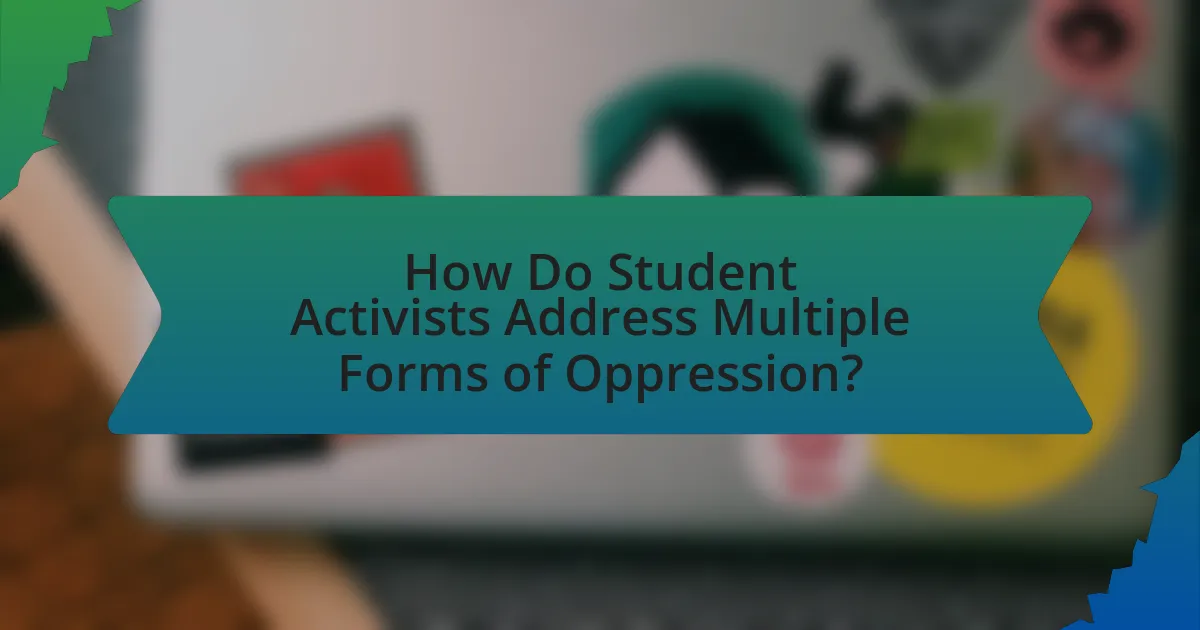
How Do Student Activists Address Multiple Forms of Oppression?
Student activists address multiple forms of oppression by employing intersectional frameworks that recognize how various social identities, such as race, gender, and class, interact to create unique experiences of discrimination. For instance, organizations like Black Lives Matter and feminist groups often collaborate to highlight the interconnectedness of racial and gender injustices, advocating for policies that address these overlapping issues. Research indicates that intersectional activism can lead to more comprehensive solutions, as seen in the 2017 Women’s March, which united diverse groups to advocate for a range of social justice issues, demonstrating the effectiveness of collective action in addressing systemic oppression.
What strategies do student activists use to combat oppression?
Student activists employ various strategies to combat oppression, including organizing protests, raising awareness through social media, and forming coalitions with other marginalized groups. Protests serve as a visible demonstration of dissent, often drawing media attention and public support, which can lead to policy changes. Social media platforms enable activists to disseminate information rapidly, mobilize supporters, and create online communities that amplify their messages. Additionally, forming coalitions allows student activists to unite diverse voices, enhancing their collective power and addressing multiple forms of oppression simultaneously, as seen in movements like Black Lives Matter and climate justice initiatives. These strategies have proven effective in influencing public opinion and prompting institutional reforms.
How do coalitions among diverse groups strengthen activism?
Coalitions among diverse groups strengthen activism by amplifying voices and uniting resources to address multiple forms of oppression. When various groups collaborate, they bring unique perspectives and experiences that enhance understanding of complex social issues. For instance, the collaboration between racial justice organizations and advocacy groups has historically led to more comprehensive strategies that tackle intersecting inequalities, as seen in movements like Black Lives Matter, which incorporates issues of gender and sexuality into its framework. This intersectional approach not only broadens the reach of activism but also fosters solidarity, making it more difficult for oppressive systems to ignore or dismiss the collective demands of a united front.
What role does education play in raising awareness about oppression?
Education plays a crucial role in raising awareness about oppression by providing individuals with the knowledge and critical thinking skills necessary to understand systemic inequalities. Through curricula that include diverse perspectives and historical contexts, education fosters empathy and encourages students to recognize and challenge injustices. For instance, studies show that students exposed to social justice education are more likely to engage in activism and advocate for marginalized communities, as evidenced by the increased participation in movements like Black Lives Matter and rights initiatives. This connection between education and activism highlights how informed individuals can effectively address and combat various forms of oppression.
How do specific movements exemplify intersectional activism?
Specific movements exemplify intersectional activism by addressing the interconnected nature of social categorizations such as race, gender, and class, which create overlapping systems of discrimination and disadvantage. For instance, the Black Lives Matter movement highlights racial injustice while also advocating for the rights of individuals and women, demonstrating how issues of race and gender intersect. Additionally, the Women’s March incorporates diverse voices, including those of marginalized communities, to emphasize that women’s rights are human rights, thus showcasing the importance of inclusivity in activism. These movements validate intersectional activism by actively engaging with multiple identities and advocating for comprehensive social justice, as evidenced by their platforms and coalition-building efforts.
What are notable examples of intersectional student movements?
Notable examples of intersectional student movements include the Black Lives Matter movement on campuses, which addresses racial injustice while also advocating for rights and gender equality. Another significant example is the March for Our Lives, which emerged from the student response to gun violence, incorporating voices from diverse racial and socioeconomic backgrounds to highlight the intersection of gun control with issues of race and class. Additionally, the #MeToo movement has seen strong student participation, focusing on sexual harassment and assault while recognizing the unique experiences of marginalized groups. These movements exemplify how student activism can effectively address multiple forms of oppression through a lens of intersectionality.
How have these movements impacted policy changes?
Student activism has significantly influenced policy changes by advocating for social justice and equity across various issues. For instance, movements such as Black Lives Matter and climate justice campaigns have led to the implementation of policies aimed at addressing systemic racism and environmental sustainability. In 2020, following widespread protests, several U.S. cities enacted police reform measures, including bans on chokeholds and increased accountability for law enforcement. Additionally, student-led initiatives for climate action have prompted universities to adopt sustainability policies, such as divesting from fossil fuels and committing to carbon neutrality by specific deadlines. These examples illustrate how student activism not only raises awareness but also drives concrete legislative and institutional changes.
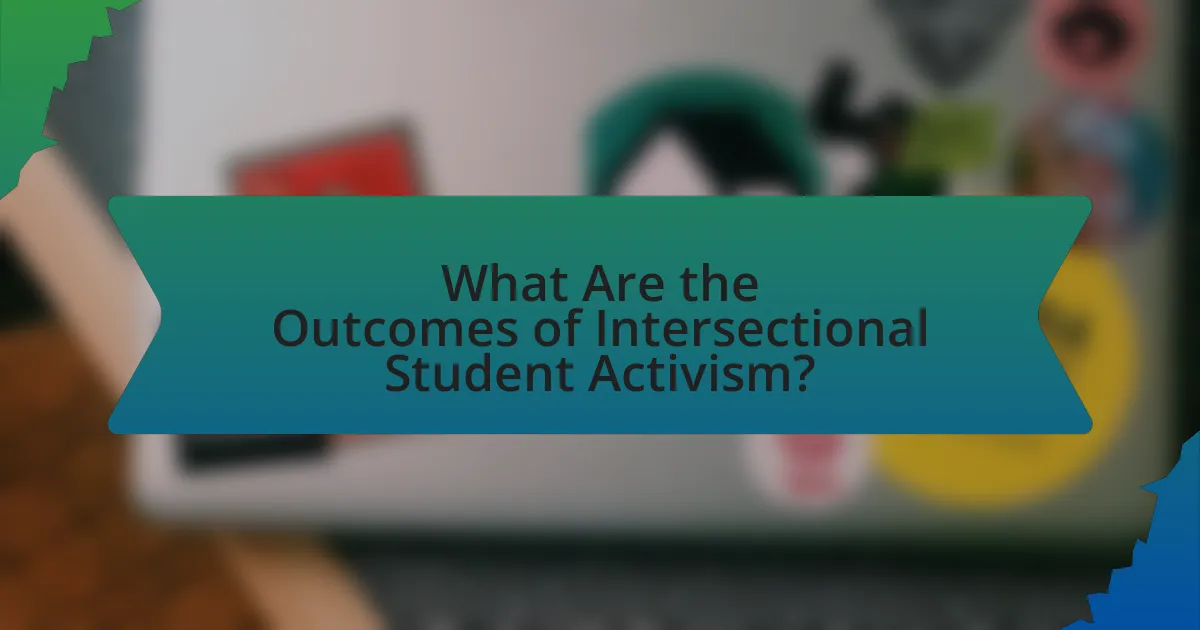
What Are the Outcomes of Intersectional Student Activism?
The outcomes of intersectional student activism include increased awareness of diverse social issues, enhanced solidarity among marginalized groups, and tangible policy changes within educational institutions. Intersectional student activism effectively highlights how various forms of oppression—such as racism, sexism, and classism—intersect, leading to a more comprehensive understanding of social justice. For instance, movements like Black Lives Matter on campuses have resulted in policy reforms aimed at improving campus safety and inclusivity, demonstrating the direct impact of such activism. Additionally, research indicates that intersectional approaches in activism foster greater engagement and participation among students, as they feel their unique identities and experiences are acknowledged and valued.
How does intersectional activism lead to social change?
Intersectional activism leads to social change by addressing the interconnected nature of social categorizations such as race, gender, and class, which create overlapping systems of discrimination and disadvantage. This approach enables activists to advocate for policies and practices that consider the diverse experiences of marginalized groups, thereby fostering inclusivity and equity. For instance, research by Crenshaw highlights how intersectionality reveals the limitations of single-issue advocacy, demonstrating that individuals facing multiple forms of oppression often experience unique challenges that require tailored solutions. By amplifying these voices and experiences, intersectional activism mobilizes broader support and drives systemic change, as seen in movements like Black Lives Matter, which integrates issues of racial justice with gender and economic inequality.
What measurable impacts have been observed from these movements?
Student activism addressing multiple forms of oppression has led to measurable impacts such as increased awareness of social justice issues, policy changes in educational institutions, and enhanced diversity initiatives. For instance, movements like Black Lives Matter on campuses have resulted in universities implementing bias training programs and revising their admissions policies to promote inclusivity. Additionally, a study by the Higher Education Research Institute found that student activism correlates with higher rates of civic engagement and political participation among students, demonstrating a long-term impact on societal involvement.
How do student-led initiatives influence broader societal perceptions?
Student-led initiatives significantly influence broader societal perceptions by challenging existing norms and advocating for social change. These initiatives often bring attention to issues such as racial inequality, climate change, and gender rights, effectively mobilizing public opinion and prompting discussions that may not have been previously considered. For instance, the March for Our Lives movement, initiated by students after the Parkland shooting, successfully shifted the national conversation on gun control, leading to increased awareness and legislative proposals aimed at reducing gun violence. This demonstrates how student activism can reshape societal views and encourage collective action towards addressing systemic issues.
What lessons can be learned from intersectional student activism?
Intersectional student activism teaches the importance of recognizing and addressing multiple forms of oppression simultaneously. This approach highlights that social justice issues are interconnected, as demonstrated by movements like Black Lives Matter, which emphasizes racial justice while also advocating for gender equality and rights. Research shows that intersectional frameworks lead to more inclusive and effective activism, as they consider the diverse experiences of marginalized groups, thereby fostering solidarity and collaboration among various social movements. For instance, a study by Crenshaw (1989) on the experiences of Black women illustrates how their unique challenges cannot be understood through a single-axis framework of race or gender alone. This underscores the necessity for activists to adopt intersectional perspectives to create comprehensive solutions that address the complexities of social injustices.
How can future activists apply these lessons in their efforts?
Future activists can apply lessons from intersectionality by recognizing and addressing the interconnected nature of various forms of oppression in their advocacy efforts. For instance, they can create inclusive campaigns that consider race, gender, class, and sexuality, ensuring that marginalized voices are represented and heard. Research shows that movements that embrace intersectionality, such as the Black Lives Matter movement, have been more effective in mobilizing diverse groups and achieving broader social change. By learning from these examples, future activists can develop strategies that foster solidarity and collaboration across different social justice issues, ultimately leading to more impactful activism.
What best practices should be adopted for effective intersectional activism?
Effective intersectional activism requires a commitment to inclusivity, collaboration, and education. Activists should prioritize listening to marginalized voices, ensuring that their experiences and needs shape the movement’s goals. Collaboration across diverse groups enhances understanding and solidarity, as seen in successful coalitions like the Women’s March, which united various social justice movements. Additionally, continuous education on intersectionality and its implications fosters awareness and empathy, enabling activists to address the complexities of oppression more effectively. Research indicates that movements that embrace intersectionality are more resilient and impactful, as they address the interconnected nature of social injustices.
